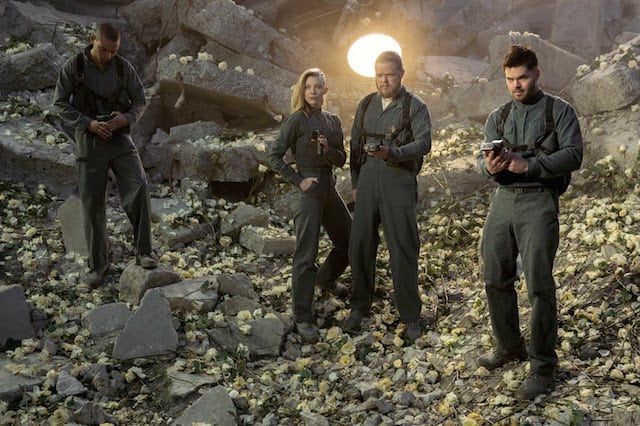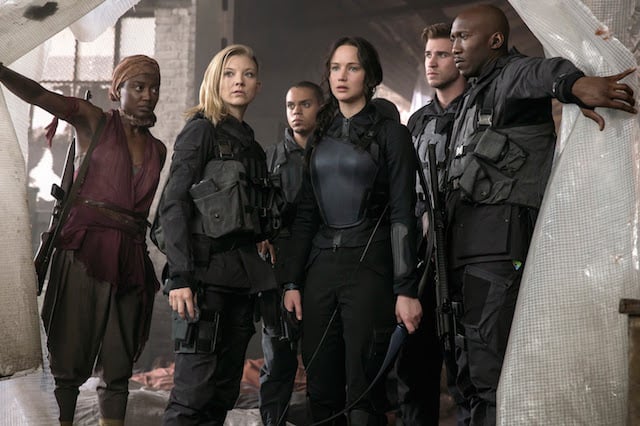This is Part 3 of a 4 part series leading up to the release of The Hunger Games: Mockingjay – Part 2, each looking at an individual film in the series and it’s legacy. Read Part 1 here, and Part 2 here.
The Hunger Games series is interested in human costs. This series is devoted to the idea that the horrors it depicts should be felt by both characters and viewers. The Hunger Games and Catching Fire create a sense of violence as it actually is; quick, brutal, and traumatizing. Mockingjay – Part 1 is interested in what can be done with these moments of violence. It’s interested in what it means to take human moments and repackage them, turning them into tools.
Mockingjay – Part 1‘s premise is full of this kind of aggressive re-branding. It suggests that Katniss, who has now become a figurehead for revolution, must take to the nation’s airwaves to unite the districts against the Capitol. When she takes to the field (it is determined that this is the only way to make her feel authentic) to deliver these messages, we immediately see how disturbing these shoots become. As Katniss stands in the ruins of a hospital that was bombed by the Capitol, she must immediately retool her emotions. The second she arrives on the scene, as a fire rages behind her, Katniss is asked to describe what she’s seeing. She is given no time to mourn the losses of those around her, no time to grieve silently for those around her. She must use their deaths as evidence, as proof that the Capitol must be destroyed.
This kind of retooling is made even worse by the fact that it works. The footage of Katniss’ speech against the Capitol is quickly changed into something worth celebrating. It becomes a 30-second ad, something not unlike a trailer for a movie. The rebels celebrate the ad, knowing that despite the tragedy which brought it about it will be an effective way to incite revolution. The chant that follows feels haunting, and this is emphasized by Katniss’s expression of horror. “You don’t like hearing a fight song at a funeral?” says Finnick. He understands the horrifying way in which turning this tragedy into a cause for celebration could easily shift, could become a justification for killing children in order to keep districts in line. Here, the human cost of the war is eliminated, forgotten behind the results that it is capable of creating.
Even Finnick seems to relegate this concern to the back of his mind though. He justifies their celebration because it will bring a speedier end to the war. In short, the ends seem to justify the means. The film seems to fight against this concept though, and does so partially through its use of Peeta’s interviews. These interviews are framed as propaganda spots for the Capitol, ones not dissimilar from the spots Katniss films. What makes them so haunting, other than Peeta’s mental and physical deterioration, is the ways in which they come with a ring of truth. He pleads for a ceasefire, refusing to accept that the only way to resolve the conflict is through violence. He suggests that a war could wipe out the country’s tiny population, and, more personally, reminds the people he’s addressing that killing has a personal cost.
Peeta’s warnings are treated with hostility. He’s a traitor, a puppet of the Capitol. This is all true of course, but his warnings feel sincere. All of his concerns are genuine ones, and the way they are delivered is consistent with Peeta’s established character. Peeta is aware of the ease with which war can be waged, ignoring the human costs of those involved. His warnings don’t stop there, though. “Can you really trust the people you’re working with?” he asks, addressing Katniss directly. The rebels use her the way the Capitol uses him, as a tool to achieve some end that she had no real part in creating, as “a piece in their games,” if you will. Katniss loses her individuality, even as she fights for “the good guys.”
President Coin leads the rebel fight. She’s as anti-Capitol as they come, and this is clear from the movie’s first moments. She is unwilling to send Katniss into battle just for effect; “we are not the Capitol,” she says. She also rejects the inherent theatricality of the Capitol, giving short speeches that work only to relay information and nothing more. Plutarch points this out after she delivers her first speech, suggesting that her oratory could use a bit more oxygen. She bites back at this remark, seeming content with the way she addresses her citizens.
By the film’s end though, Coin begins to understand the ways in which Plutarch may have been right. Her final speech, delivered after Peeta and the other victors are successfully extracted from the Capitol, is notably bombastic. She is triumphant, and delivers a victory speech full of rhetoric and dramatic flare. The influence of the Capitol on her speech is so notable that, in one particularly brilliant cut, we see Plutarch mouthing the words of the speech along with Coin. He clearly had a hand in them. These words are coming from the mind of a Capitol citizen, not one who has lived in District 13 her entire life.
Coin has appropriated a Capitol mentality not just in her speeches, but in her actions as well. The Peeta she rescued from the Capitol is emotionally unstable, not the boy many are familiar with from the last two Hunger Games. Peeta’s attack on Katniss is incredibly detrimental, an enormous tragedy which Coin ultimately finds inconsequential. For her, what matters is not Peeta’s state of mind, but his existence inside District 13. He acts as proof that the rebels can infiltrate the Capitol and retrieve what they hold captive. Coin’s inability to appreciate the human tragedy at work is underlined in the finale. As she delivers her triumphant speech, Katniss observes Peeta’s manic attempts to free himself from his restraints. This moment is horrible, tragic, and deeply personal. As we hear the war cries of District 13, we know that they do not feel this moment the way she does. It has been repackaged for them, courtesy of President Coin.
Genuine emotion is everywhere in this series. It’s in the bombing of District 8, in the aftermath of Katniss’ first and second Hunger Games, and in the utter hopelessness of her expression as she gazes at a deranged Peeta. The Hunger Games series, unlike so many blockbuster franchises, is interested in what these feelings are, not in how they might entertain us. The Hunger Games and Catching Fire work hard to maintain their emotional cores, but Mockingjay – Part 1 seems to abuse its own. It takes its human moments, ones that make Katniss question those around her or destroy what little sanity she has left, and makes them into tools. A moment of horror becomes one of triumph, a moment of weakness becomes a show of strength. Mockingjay – Part 1 wants to make your skin crawl, as you watch it throw giant parties on freshly buried graves.
If we have been desensitized to violence and its aftereffects, as The Hunger Games and Catching Fire suggest, then Mockingjay – Part 1 suggests how this happens. It suggests that humanity is sapped from these horrors, replaced by simple utilitarianism. We take the violence, the emotion, the heartbreak, and the terror, and we use it all as entertainment. We separate ourselves from it, tell ourselves that the things we witness are worth it somehow. We tell ourselves that this death prevented someone else’s, or is part of some bigger cause. This mentality is one that infects both sides in this war. The truth is far simpler than justifiable death, though. We take these tragedies because they give us fuel, because they’re what we know how to use. There’s a reason news broadcasts are so depressing, and it’s not that no good things ever happen. Darkness sells, and Mockingjay – Part 1 knows it.



